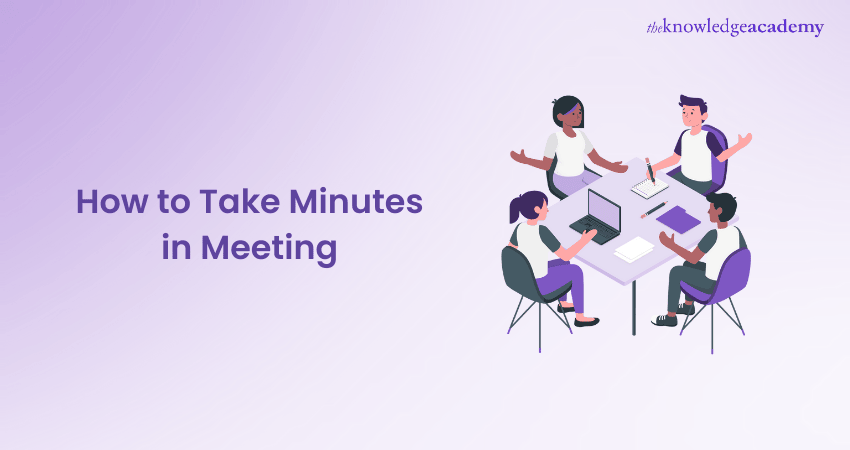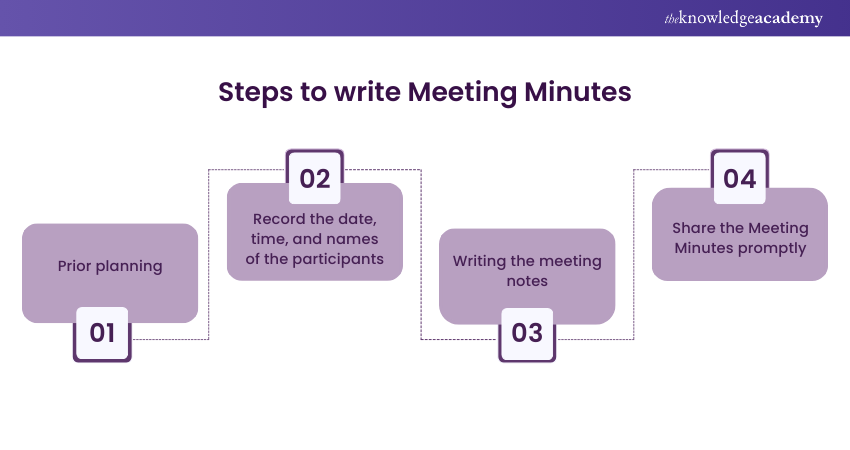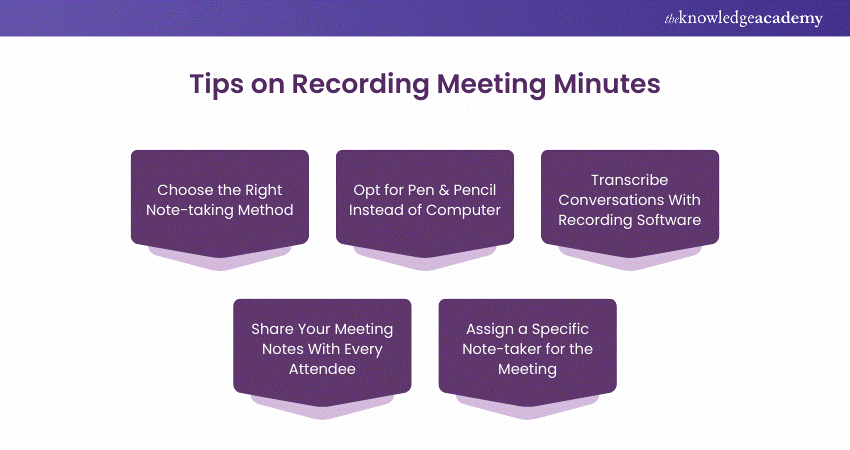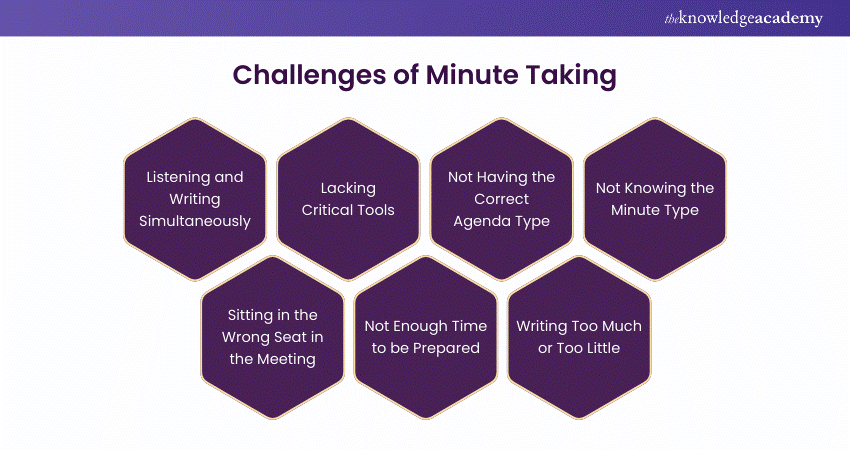We may not have the course you’re looking for. If you enquire or give us a call on +357 26030221 and speak to our training experts, we may still be able to help with your training requirements.
We ensure quality, budget-alignment, and timely delivery by our expert instructors.

Imagine a meeting as a vibrant melting pot where minds and ideas converge to shape the future of an organisation. In this context, How To Take Minutes In the Meeting serve as the essential map that charts this journey. These minutes are the written record of all critical decisions made during the meeting. So, learning How to Take Minutes in a Meeting with a standardised approach is essential to avoid any confusion.
Imagine a meeting as a vibrant melting pot where minds and ideas converge to shape an organisation’s future. How To Take Minutes In a Meeting becomes an essential skill in this lively environment, as the Minutes of the Meeting act as the critical map that captures every important decision made. By following a standardised approach to taking minutes, you can prevent any confusion and keep everyone aligned with key outcomes.
In this blog, we’ll explore How To Take Minutes In a Meeting and why it matters, along with helpful tips and techniques for taking them more efficiently. Let’s dive in and master this skill!
Table of Contents
1) What are Minutes in a Meeting?
2) How to Take Minutes in a Meeting?
a) Prior Planning
b) Record the Date, Time, and Names of the Participants
c) Writing the Meeting Notes
d) Share the Meeting Minutes Promptly
3) Tips on How to Take Effective Meeting Minutes
4) Challenges in Recording Minutes In Meeting
5) Conclusion
What are Minutes in a Meeting?
The Meeting Minutes are the written document of all the critical decisions that are made during the meeting period. Whether for an organisation’s Board of Directors, leaders, or investors, this knowledge is easily transferable. They are also referred to as ‘Minutes of Meetings’ (MoM).
A meeting transcript serves as a valuable resource for informing absent members about the decisions made. It also acts as a reference for revisiting and reviewing past decisions.
How to Take Minutes in a Meeting?
Effectively taking Meeting Minutes ensures that all key decisions, action items, and important discussions are documented accurately. By following a structured approach, you can produce clear, organised, and actionable records that ensure alignment and accountability for all.

1) Prior Planning
Effective preparation before a meeting can significantly simplify the task of taking minutes. Here are some key steps to ensure you're well-prepared:
a) Understand the Agenda: Speak with the person in charge before the meeting to get a clear idea of the agenda. This allows you to prepare your talking points in advance.
b) Identify Meeting Intentions: Knowing the purpose and topics of discussion helps you focus on what to note. This preparation ensures you capture all relevant information.
c) Prepare Notes in Advance: Draft notes on the talking points, the meeting's purpose, and the expected time frame. This groundwork helps you structure your minutes effectively.
Take the next step towards enhancing your professional skills in administration and secretarial roles with our PA and Secretarial Training – sign up now!
2) Record the Date, Time, and Names of the Participants
Recording the date, time, and names of participants is essential for effective meeting minutes. Here are some steps to ensure you capture this information accurately:
a) State the Date and Time: Begin by clearly noting the date and time of the meeting. This provides a reference point for reviewing past meetings and tracking progress.
b) List Participants: Record the names of all attendees and those who were absent. This helps in understanding who was involved in the discussions and decisions.
c) Review Previous Minutes: Meetings often start with a review of the previous minutes. This helps you identify who attended the last meeting and prepare an initial draft of the attendee list.
d) Crosscheck with Calendar Invites: Use the calendar invite to verify the names of participants as they join the meeting. This ensures your list is accurate and up-to-date.
3) Writing the Meeting Notes
Writing effective meeting notes is crucial for maintaining clear and actionable records. Here are some key steps to help you create a precise meeting summary:
a) Write Notes Promptly: Avoid delaying the note-taking process after the meeting. This helps you recall all the actions and discussions accurately.
b) Review and Adjust the Format: Revisit the format you planned earlier and make any necessary adjustments. This could involve clarifying queries or providing further explanations on discussed matters. Ensure you have clear records of all activities, decisions, and motions.
c) Revise for Clarity: Go through your minutes to ensure they are concise and clear.
d) Attach Important Documents: Include any relevant documents that were discussed or referenced during the meeting.
e) Proofread Thoroughly: Check for clarity and eliminate any grammatical or spelling errors to ensure your notes are professional and easy to understand.
Join our renowned Train the Trainer Course and gain the expertise you need to inspire and educate others effectively.
4) Share the Meeting Minutes Promptly
Sharing the meeting minutes promptly is essential for ensuring everyone is informed and aligned. Here are some steps to follow:
a) Send to Key Leaders First: Make the corrections and approve it if there are any necessary revisions. Once you have all the necessary approvals, you can now send the meeting notes to the respective employees, ensuring your Minute Taking Skills are reflected in the clarity and accuracy of the document.
b) Obtain Necessary Approvals: Ensure all relevant individuals have approved the notes and added their signatures. Make any necessary corrections and finalise the document.
c) Distribute to Employees: Once you have all the necessary approvals, distribute the meeting notes to the respective employees.
d) Choose an Appropriate Method: Select a method that suits your business style for sharing the minutes, such as email. Verify the list of recipients with your leaders and include any additional employees as instructed.
Unlock your potential and become a master in secretarial skills with our comprehensive Secretarial Course – Sign up now!
Tips on How to Take Effective Meeting Minutes
Taking minutes in meetings is a vital responsibility that requires careful attention and effective communication. Well-crafted Meeting Minutes provide a concise and accurate record of discussions, decisions, and action items. Here are some valuable tips for Minute-Taking that can enhance your knowledge of How to Take Meeting Minutes:

1) Choose a Note-taking Method that Works For You
There are numerous different note-taking methods out there, and it's essential to settle on the one that works best for you based on your personal learning style. Some of the common note-taking methods include:
a) Cornell Method: In the Cornell method, notes take the form of two columns: A small left-side column and a larger column on the right. The left column outlines key points from the meeting, while the right column highlights the details. Noting the main idea on the left and important details on the right can help you stay organised as the conversation shifts.
b) Outline Method: Since the meeting agenda is generally shared beforehand, use that as an outline for your notes. List the key points and agenda items, then take notes underneath each as the meeting progresses.
c) Quadrant Method: You can separate your notes into four different quadrants, labelling each section as:
a) General notes,
b) Action items for yourself
c) Action items for other team members
d) Questions
In the general notes section, note down essential details from the meeting while you can reserve the rest of the quadrants for the items underneath those headers.
d) Slide Method: If your meeting is a presentation, request the presenter to share the slide deck with you ahead of time. You can then add any notes to specific slides as the speaker presents.
2) Ditch the Laptop—Use Pen and Paper Instead
Using pen and paper for taking notes for meeting can be highly beneficial. Here are some key points to consider:
a) Enhance Memory Retention: Research indicates that handwriting notes help you remember conceptual information better in the long term.
b) Focus on Key Takeaways: When using pen and paper, your focus will naturally shift to the most important points, as it's nearly impossible to write everything down verbatim.
c) Reduce Multitasking: Not having your laptop during meetings minimises the temptation to multitask, allowing you to stay fully engaged with the discussion.
3) Transcribe Conversations with Recording Software
Using recording software to transcribe conversations can be highly effective, especially for remote teams. Here are some key points to consider:
a) Simplify Note-Taking: Recording and sharing a video can be easier than writing meeting notes, allowing team members to access the conversation later.
b) Utilise Transcription Software: Use recording software to transcribe the conversation, making it easy to identify critical points and action items at a glance.
c) Inform Participants: Before starting, inform everyone that the conversation will be recorded and explain the purpose of the recording.
d) Share Accessibly: Share the recording and transcript in a central location that is accessible to the entire team.
4) Share Your Meeting Notes with All Attendees
Sharing your meeting notes with all attendees is crucial for ensuring clarity and alignment. Here are some key steps to follow:
a) Follow Up with Stakeholders: After the meeting, follow up to ensure all stakeholders understand the decisions made. This helps anyone who missed the meeting catch up asynchronously by reading the notes.
b) Include Missed Points: If there are any missed points, your team can add them to the follow-up notes, ensuring nothing is overlooked.
c) Ensure Accessibility: Make sure the document is easily shareable and accessible. Work with your team to develop a communication plan, so everyone knows where the information is stored and how to access it later.
5) Assign a Specific Note-taker for the Meeting
Assigning a specific note-taker for the meeting can be highly effective. Here are some key points to consider:
a) Delegate Note-Taking: If you're leading the meeting, it can be challenging to take notes and facilitate the discussion simultaneously. Ask a team member to take notes for you.
b) Rotate the Role: For recurring meetings, rotate the designated note-taker. This allows everyone to get involved in the conversation and share their responsibility.
Need help with meeting minutes? Grab the Effective Minute-Taking PDF and excel!
Challenges in Recording Minutes in Meeting
Taking accurate meeting minutes can be daunting, especially for those new to the process. Even seasoned minute-takers can encounter hurdles that affect the clarity and completeness of their records. Here are some common challenges associated with Minute-Taking:

1) Using Two Complex Skills at Once: Listening and writing simultaneously can be challenging. It's all about concentrating on what is being said while suspending your views and judgment.
2) Missing Key Tools: It would help if you had these essential Minte Taking Tools during Minute-Taking:
a) A supply of sharpened pencils. If you really use a pen, a lightweight, quality biro works better than most.
b) Smooth, good-quality paper.
c) An A5 spiral-bound hardcover pad. It works better than an A4 one.
d) Tent cards and a seating plan
e) The previous set of minutes and the current agenda
3) Wrong Agenda Type: An action-centred agenda is crucial to meeting success. Send it out at least a week before the meeting and ensure it is well structured and fits into the timeframe of the meeting. It must also use basic psychological principles about how people behave at meetings, especially regarding time slots, running order, and precise objectives for each item. Additionally, it should offer pointers on any background papers and clearly indicate who is leading on each item to maintain structure and efficiency.
4) Not Knowing the Type of Minute, You Should be Producing: You need to know the four options beforehand. Usually, a meeting will have the same number of minutes each time and as long as they are well written, checking previous minutes will show you which type you must produce.
The types of minutes you can choose from include:
a) Verbatim (rare).
b) Narrative (commonly used).
c) Resolution (often used in public bodies).
d) Action (preferable for many types of meetings these days).
e) The layout, structure, and recording levels are different for each.
5) Sitting in the Wrong Seat: If you are taking the minutes, your place is by the chairperson.
6) Inadequate Preparation: If you are new to this, you must allocate time beforehand, preferably several weeks before the meeting. Look back over six months of previous minutes of your meeting as it will show you:
a) Level of recording
b) The story so far
c) Level of detail
d) Decision-making and problem-solving methods used
e) The people involved
f) The major contributors
7) Excessive or Insufficient Writing: Generally speaking, you need to note only crucial points, decisions, and actions. Practice will help you get the balance right. If you try to note too much down, you will stay caught up in the discussion, and your writing will become illegible. So, you will have a tough time transcribing it back into something concise, accurate and meaningful when you return to work.
How to Share Minutes in a Meeting?
To share meeting minutes effectively, start by creating a concise but clear summary of the discussion points, decisions made, and assigned tasks. Ensure your email or document is well-organised with headings, bullet points, and timestamps, making it easy to reference later. According to eMeet, adopting a consistent format helps participants quickly identify critical information and action items without sifting through lengthy text.
After drafting your minutes, proofread them for accuracy and include important details like the meeting date and attendees. In your email subject line, clearly mention the meeting minutes and specify the date, helping readers quickly locate the information in their inboxes. Finally, attach any relevant documents and set deadlines or next steps so everyone knows what’s expected of them moving forward.
What to Include When Writing Meeting Minutes?
When writing meeting minutes, it’s vital to capture the essential details right at the start: date, time, and location of the meeting. According to Wild Apricot, you should also note the purpose of the meeting, list all attendees, and outline each agenda item discussed, providing brief but clear summaries instead of long, unnecessary details.
In addition, you should record every decision made, as well as action items and deadlines that arise. This helps prevent any sort of confusion about who is responsible for which tasks. Maintaining clarity and consistency throughout your minutes ensures everyone can quickly reference key points and assignments without sifting through excessive kinds of text.
Become proficient in advanced Scheduling Software- Sign up for our Perfect Executive Personal Assistant Training today!
Conclusion
Mastering the art of How to Take Minutes In a Meeting can significantly impact the success of a meeting. It involves concentrating on key decisions, enhancing your listening and writing skills, and preparing in advance by understanding the meeting's context. This blog provides comprehensive guidance on developing and perfecting Minute-Taking skills.
Unleash your potential and master the art of shorthand with our comprehensive Shorthand Training – Sign up today!
Frequently Asked Questions
Can Effective Minute-taking Contribute to Career Advancement within an Organisation?

Yes, effective minute taking shows your eye for details and precision in documentation. It also displays what a valuable employee you are, and companies like to retain employees who bring value to the company as well as are experienced with the way things work in the company.
How can I Stay Updated on the Latest Trends and Best Practices in Minute-taking for Career Growth?

The best way to update yourself with the latest trends and improve your skills is to take up the latest workshops and courses related to PA training or Minute-Taking training. You can also reach out to management to cover the course expenses as an up-skill opportunity.
What are the Other Resources And Offers Provided by The Knowledge Academy?

The Knowledge Academy takes global learning to new heights, offering over 3,000 online courses across 490+ locations in 190+ countries. This expansive reach ensures accessibility and convenience for learners worldwide.
Alongside our diverse Online Course Catalogue, encompassing 19 major categories, we go the extra mile by providing a plethora of free educational Online Resources like News updates, Blogs, videos, webinars, and interview questions. Tailoring learning experiences further, professionals can maximise value with customisable Course Bundles of TKA.
What is Knowledge Pass, and How Does it Work?

The Knowledge Academy’s Knowledge Pass, a prepaid voucher, adds another layer of flexibility, allowing course bookings over a 12-month period. Join us on a journey where education knows no bounds.
What are the Related Courses and Blogs Provided by The Knowledge Academy?

The Knowledge Academy offers various PA and Secretarial Courses, including Secretarial, Office Skills and Office Manager Courses. These courses cater to different skill levels, providing comprehensive insights into the Benefits of a Company Secretary.
Our Business Skills Blogs cover a range of topics related to PA and Secretarial Courses, offering valuable resources, best practices, and industry insights. Whether you are a beginner or looking to advance your PA and Secretarial skills, The Knowledge Academy's diverse courses and informative blogs have you covered.
Upcoming Business Skills Resources Batches & Dates
Date
 Company Secretary Training Course
Company Secretary Training Course
Fri 11th Apr 2025
Fri 13th Jun 2025
Fri 15th Aug 2025
Fri 10th Oct 2025
Fri 12th Dec 2025






 Top Rated Course
Top Rated Course



 If you wish to make any changes to your course, please
If you wish to make any changes to your course, please


